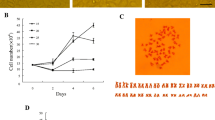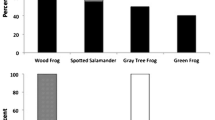Abstract
The capacity of rainbow trout, Oncorhynchus mykiss, to be a host for frog virus 3 (FV3) was evaluated at the cellular level. Cell cultures from this species were tested for their ability to express FV3 major capsid protein (MCP) gene, to develop cytopathic effect (CPE), and to produce FV3. After FV3 addition, MCP transcripts were detected in six of six cell lines and in primary macrophage cultures. CPE developed in all cell culture systems, except primary lymphocytes. For the macrophage cell line, RTS11, and primary macrophages, cell death was by apoptosis because DNA laddering and Annexin staining were detected. By contrast, markers of apoptosis did not accompany CPE in three epithelial cell lines from the gill (RTgill-W1), intestine (RTgut-GC), and liver (RTL-W1) and in two fibroblast cell lines from gonads (RTG-2) and skin (RTHDF). Therefore, FV3 was able to enter and begin replicating in several cell types. Yet, FV3 was produced in only two cell lines, RTG-2 and RTL-W1, and only modestly. Overall, these results suggest that if tissue accessibility were possible, FV3 would have the capacity to induce injury, but the ability to replicate would be limited, likely making rainbow trout a poor host for FV3.





Similar content being viewed by others
References
Ariel E, Nicolajsen N, Christophersen M, Holopainen R, Tapiovaara H, Jensen BB (2009) Propagation and isolation of ranaviruses in cell culture. Aquaculture 294:159–164
Ariel E, Holopainen R, Olesen NJ, Tapiovaara H (2010) Comparative study of ranavirus isolates from cod (Gadus morhua) and turbot (Psetta maxima) with reference to other ranaviruses. Arch Virol 155:1261–1271
Ashford RW (2003) When is a reservoir not a reservoir? Emerg Infect Dis 9:1495–1496
Bollinger TK, Mao J, Schock D, Brigham RMM, Chinchar VG (1999) Pathology, isolation and preliminary molecular characterization of a novel iridovirus from tiger salamanders in Saskatchewan. J Wildlife Dis 35:413–429
Bols NC, Mosser DD, Steels GB (1992) Temperature studies and recent advances with fish cells in vitro. Comp Biochem Physiol 1992(103A):1–14
Bols NC, Barlian A, Chirino-Trejo M, Caldwell SJ, Goegan P, Lee LEJ (1994) Development of a cell line from primary cultures of rainbow trout, Oncorhynchus mykiss (Walbaum), gills. J Fish Dis 17:601–611
Brenes R, Gray MJ, Waltzek TB, Wilkes RP, Miller DL (2014a) Transmission of ranavirus between ectothermic vertebrate hosts. PLoS ONE 9(3):e92476
Brenes R, Miller DL, Waltzek TB, Wilkes RP, Tucker J, Chaney JC, Hardman RH, Brand MD, Huether RR, Grey MJ (2014b) Susceptibility of fish and turtles to three Ranaviruses isolated from different ectothermic vertebrate classes. J Aquat Animal Health 26:118–126
Brubacher JL, Secombes CJ, Zou J, Bols NC (2000) Constitutive and LPS-induced gene expression in a macrophage-like cell line from the rainbow trout (Oncorhynchus mykiss). Dev Comp Immunol 24(6-7):565–574
Chan JFW, Chan KW, Choi GKY, To KKW, Tse H, Cai JP, Yeung ML, Chen H, Che XY, Lau SKP, Woo PCY, Yuen KY (2013) Differential cell line susceptibility to the emerging novel human betacoronavirus 2c EMC/2012: implications for disease pathogenesis and clinical manifestation. J Infect Dis 207:1743–1752
Chinchar VG, Waltzek TB (2014) Ranaviruses: not just for frogs. PLoS Pathog 10(1):530. doi:10.1371/journal.ppat.1003850, e1003850
Chinchar VG, Bryan L, Wang J, Long S, Chinchar GD (2003) Induction of apoptosis in frog virus 3-infected cells. Virology 306:303–312
Chinchar VG, Yu KH, Jancovich JK (2011) The molecular biology of frog virus 3 and other iridoviruses infecting cold-blooded vertebrates. Viruses 3:1959–1985
Dayeh VR, Bols NC, Tanneberger K, Schirmer K, Lee LE (2013) The use of fish-derived cell lines for investigation of environmental contaminants: an update following OECD's fish toxicity testing framework No. 171. Curr Protoc Toxicol. doi:10.1002/0471140856.tx0105s56
Eaton HE, Metcalf J, Penny E, Tcherepanov V, Upton C, Brunetti CR (2007) Comparative genomic analysis of the family iridoviridae: re-annotating and defining the core set of iridovirus genes. Virol J 4(11):1
Eaton HE, Metcalf J, Brunetti CR (2008) Expression of frog virus 3 genes is impaired in mammalian cell lines. Virol J 5:83
Ganassin RC, Bols NC (1998) Development of a monocyte/macrophage-like cell line, RTS11, from rainbow trout spleen. Fish Shellfish Immunol 8:457–476
Gobbo F, Cappellozza E, Pastore MR, Bovo G (2010) Susceptibility of black bullhead Ameiurus melas to a panel of ranavirus isolates. Dis Aquat Org 90:167–174
Gravell M, Granoff A (1970) Viruses and renal carcinoma of Rana pipiens. IX. the influence of temperature and host cell on replication of frog polyhedral cytoplasmic deoxyribovirus (PCDV). Virology 41:596–602
Grayfer L, Robert J (2014) Divergent antiviral roles of amphibian (Xenopus laevis) macrophages elicited by colony-stimulating factor-1 and interleukin-34. J Leukoc Biol 96(6):1143–1153
Grayfer L, De Jesus AF, Chen G, Chinchar GV, Robert J (2012) Immune evasion strategies of Ranaviruses and innate immune responses to these emerging pathogens. Viruses 4:1075–1092
Guo CJ, Liu D, Wu YY, Yang XB, Yang LS, Mi S, Huang YX, Luo YW, Jia KT, Liu ZY, Chen WJ, Weng SP, Yu XQ, He JG (2011) Entry of tiger frog virus (an Iridovirus) into HepG2 cells via a pH-dependent, atypical, caveola-mediated endocytosis pathway. J Virol 85:6416–6426
Gut JP, Anton M, Bingen A, Vetter JM, Kirn A (1981) Frog virus 3 induces a fatal hepatitis in rats. Lab Invest 45:218–228
Holopainen R, Honkanen J, Jensen BB, Ariel E, Tapiovaara H (2011) Quantitation of ranavirus in cell culture and tissue samples. J Virol Methods 171:225–233
Holopainen R, Tapiovaara H, Honkanen J (2012) Expression analysis of immune response genes in fish epithelial cells following ranavirus infection. Fish Shellfish Immunol 32:1095–1105
Jensen BB, Ersboll AK, Ariel E (2009) Susceptibility of pike Esox lucius to a panel of Ranavirus isolates. Dis Aquat Org 83:169–179
Jensen BB, Holopainen R, Tapiovaara H, Ariel E (2011a) Susceptibility of pike-perch Sander lucioperca to a panel of ranavirus isolates. Aquaculture 313:24–30
Jensen BB, Reschova S, Cinkova K, Ariel E, Vesely T (2011b) Common carp (Cyprinus carpio) and goldfish (Carassius auratus) were not susceptible to challenge with ranaviruses under certain challenge condtions. Bull Eur Ass Fish Pathol 31:112–118
Karber G (1931) Beitrag zur kollektiven Behandlung pharmakologischer Reihenversuche. Naunyn Schmiedebergs Arch Exp Pathol Pharmakol 162:480–483
Kawano A, Haiduk C, Schirmer K, Hanner R, Lee LEJ, Dixon B, Bols NC (2011) Development of a rainbow trout intestinal epithelial cell line and its response to lipopolysaccharide. Aquac Nutr 17:e241–e252
Kroemer G, Galluzzi L, Vandenabeele P, Abrams J, Alnemri ES, Baehrecke EH, Blagosklonny MV, El-Deiry WS, Golstein P, Green DR, Hengartner M, Knight RA, Kumar S, Lipton SA, Malorni W, Nuñez G, Peter ME, Tschopp J, Yuan J, Piacentini M, Zhivotovsky B, Melino G (2009) Nomenclature Committee on Cell Death 2009. classification of cell death: recommendations of the Nomenclature Committee on Cell Death 2009. Cell Death Differ 16:3–11
Lee LEJ, Clemons JH, Bechtel DG, Caldwell SJ, Han K, Pasitschniak-Arts M, Mosser DD, Bols NC (1993) Development and characterization of a rainbow trout liver cell line expressing cytochrome P450-dependent monooxygenase activity. Cell Biol Toxicol 9:279–294
Leimbach S, Schultze H, Bergmann SM (2014) Susceptibility of European sheatfish Silurus glanis to a panel of ranaviruses. J Appl Ichthyol 30:93–101
Mao J, Tham TN, Gentry GA, Aubertin AM, Chinchar VG (1996) Cloning, sequence analysis, and expression of the major capsid protein of the iridovirus frog virus 3. Virology 216:431–436
Miller D, Gray M, Storfer A (2011) Ecopathology of ranaviruses infecting amphibians. Viruses 3:2352–2373
Mocarski DS, Kaiser WJ, Livingston-Rosanoff D, Upton JW, Daley-Bauer LP (2014) True grit: programmed necrosis in antiviral host defense, inflammation, and immunogenicity. J Immunol 192:2019–2026
Morales HD, Abramowitz L, Gertz J, Sowa J, Vogel A, Robert J (2010) Innate immune responses and permissiveness to ranavirus infection of peritoneal leukocytes in the frog Xenopus laevis. J Virol 84:4912–4922
Nazir J, Spengler M, Marschang RE (2012) Environmental persistence of amphibian and reptilian ranviruses. Dis Aq Org 98:177–184
Ossum CG, Hoffmann EK, Vijayan MM, Holts SE, Bols NC (2004) Characterization of a novel fibroblast-like cell line from rainbow trout and response to sublethal anoxia. J Fish Dis 64:1103–1116
Petrenko YA, Gorokhova NA, Tkachova EN, Petrenko AY (2005) The reduction of Alamar Blue by peripheral blood lymphocytes and isolated mitochondria. Ukr Biokhim Zh 77(5):100–105
Pham PH, Lai YS, Lee FF, Bols NC, Chiou PP (2012) Differential viral propagation and induction of apoptosis by grouper iridovirus (GIV) in cell lines from three non-host species. Virus Res 167:16–25
Picco AM, Karam AP, Collins JP (2010) Pathogen host switching in commercial trade with management recommendations. EcoHealth 7:252–256
Rampersad SN (2012) Multiple applications of Alamar Blue as an iIndicator of metabolic function and cellular health in cell viability bioassays. Sensors (Basel) 12:12347–12360
Rebel A, Verleigh M, Kobis J, Kuhn C, Wimmers K, Kollner B, Goldammer T (2013) Transcriptome profiling of gill tissue in regionally bred and globally farmed rainbow trout strains reveals different strategies for coping with thermal stress. Mar Biotechnol 15:445–460
Robert J, Abramowitz L, Gantress J, Morales HD (2007) Xenopus laevis: a possible vector of Ranavirus infection? J Wildl Dis 43:645–652
Roulston A, Marcellus RC, Branton PE (1999) Viruses and apoptosis. Annu Ver Microbiol 53:577–628
Upton JW, Chan FKM (2014) Staying alive: cell death in antiviral immunity. Mol Cell 54:273–280
Vilagines R, McAuslan BR (1970) Restricted replication of frog virus 3 in selected variants of BHK cells. J Virol 6:303–309
Virgin HW (2014) The virome in mammalian physiology and disease. Cell 157:142–150
Waltzek TB, Miller DL, Gray MJ, Drecktrah B, Briggler JT, MacConnell B, Hudson C, Hopper L, Friary J, Yun SC, Malm KV, Weber ES, Hedrick RP (2014) New disease records for hatchery-reared sturgeon. I. expansion of frog virus 3 host range into Scaphirhynchus albus. Dis Aquat Organ 111(3):219–227
Webby R, Hoffmann E, Webster R (2004) Molecular constraints to interspecies transmission of viral pathogens. Nat Med Suppl 10:S77–S81
Winton J, Batts W, deKinkelin P, LeBerre M, Bremont M, Fijan N (2010) Current lineages of the epithelioma papulosum cyprinid (EPC) cell line are contaminated with fathead minnow, Pimephales promelas, cells. J Fish Dis 33: 701–704
Wolf K, Quimby MC (1962) Established eurythermic line of fish cells in vitro. Science 135:1065–1066
Acknowledgments
This work was funded by the Natural Science and Engineering Research Council (NSERC) of Canada Discovery grant (6523) to NCB and an NSERC graduate scholarship to PHP.
Author information
Authors and Affiliations
Corresponding author
Additional information
Editor: T. Okamoto
Rights and permissions
About this article
Cite this article
Pham, P.H., Huang, Y.J., Mosser, D.D. et al. Use of cell lines and primary cultures to explore the capacity of rainbow trout to be a host for frog virus 3 (FV3). In Vitro Cell.Dev.Biol.-Animal 51, 894–904 (2015). https://doi.org/10.1007/s11626-015-9911-1
Received:
Accepted:
Published:
Issue Date:
DOI: https://doi.org/10.1007/s11626-015-9911-1




